Art World
Judith Scott Defied Stereotypes About Down Syndrome and Became a Famous Sculptor. A Poignant New Children’s Book Tells Her Story
Coauthor and illustrator Melissa Sweet on how she helped adapt Scott's biography for children.
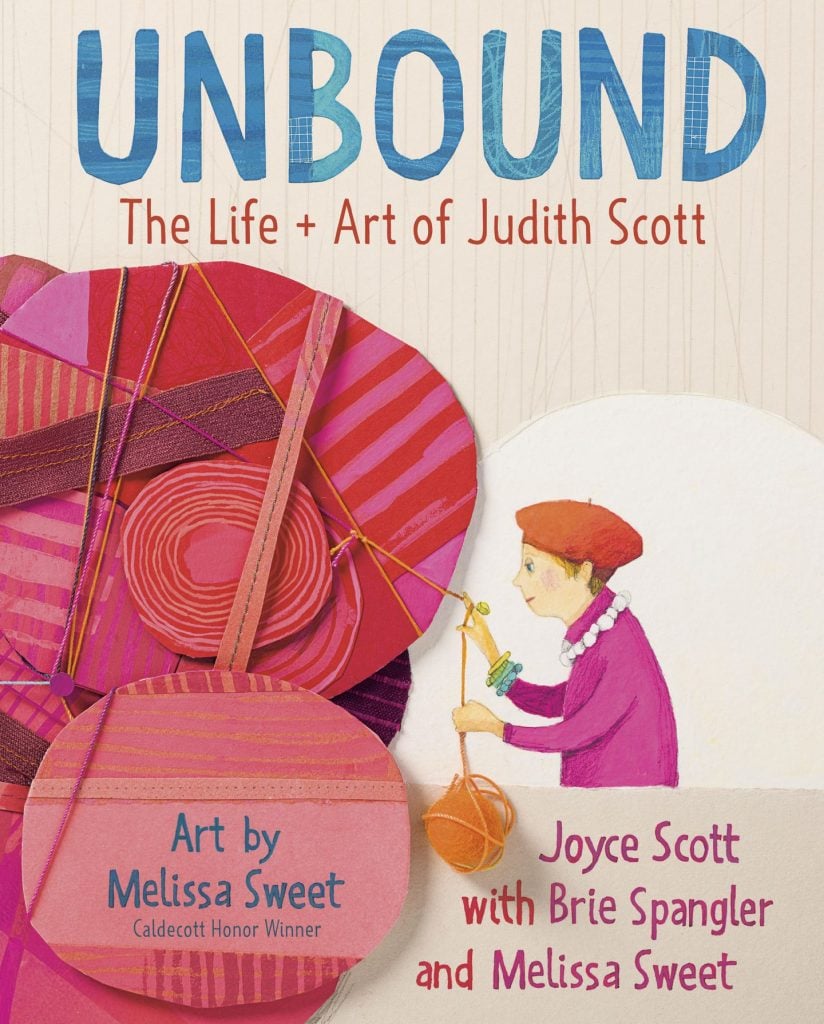
Coauthor and illustrator Melissa Sweet on how she helped adapt Scott's biography for children.

Sarah Cascone

When Joyce Scott was seven years old, her parents sent her twin sister Judith Scott, who had Down Syndrome, to live in an institution for the mentally disabled—an unimaginable loss for both girls. Thirty-six years later, Joyce was finally able to bring her sister home, and enrolled her at the Creative Growth Art Center in Oakland, where Scott revealed herself to be a talented fiber artist.
Now, the story of the Scott sisters has become a new picture book biography by Joyce and co-authors Brie Spangler and Melissa Sweet, who also provided the illustrations.
Sweet, who has published over 100 children’s books, learned of Scott’s work from a friend with an interest in Outsider art. She was immediately captivated by the unique, densely wrapped sculptures.
“The word mesmerized comes to mind,” Sweet told Artnet News. “I saw a cocoon, almost a three-dimensional painting. How she thought to use fiber was so interesting to me—they felt like treasures. They were like nothing I had seen before.”
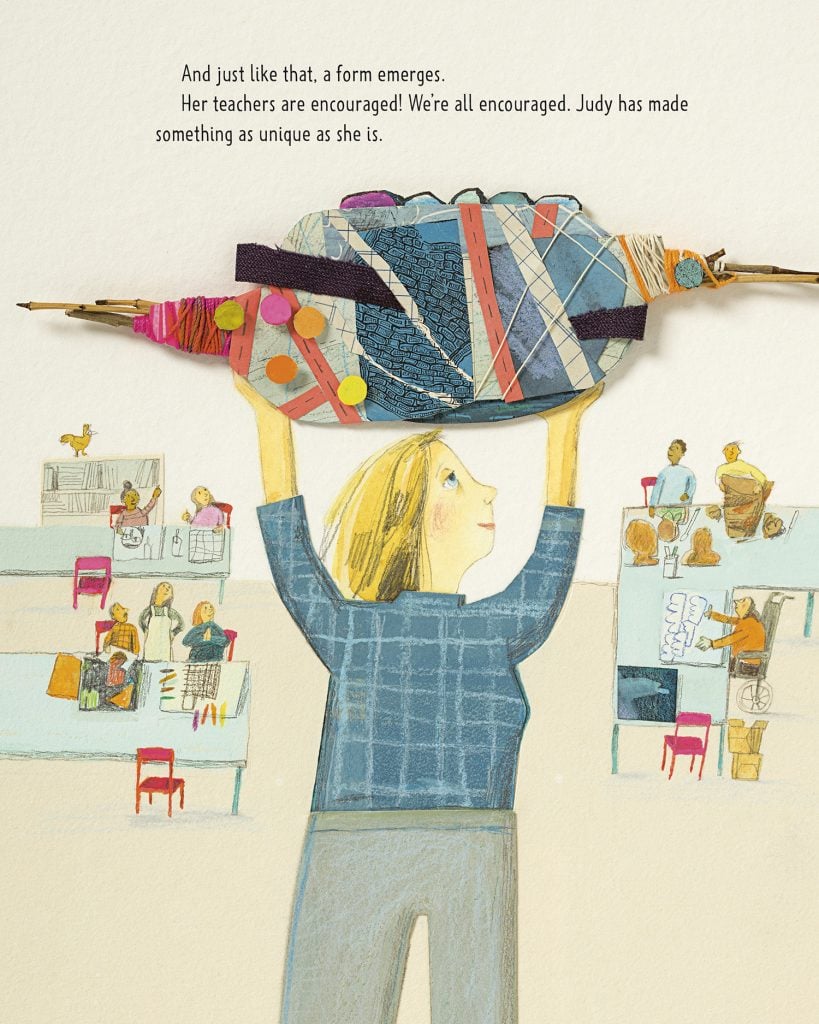
Joyce Scott, Brie Spangler, and Melissa Sweet, Unbound: The Life + Art of Judith Scott. Courtesy of Knopf Books for Young Readers, Penguin Random House.
When Sweet was approached about working on Unbound: The Life + Art of Judith Scott, there was not a moment’s hesitation.
“It’s about family, it’s about people with disabilities, and it’s about the value of making art,” she said.
Embracing art at the Creative Growth Art Center gave Scott—who could not speak or sign—a new way to communicate over the last 18 years of her life, delicately wrapping yarn and other materials around found objects to create over 200 bound and layered sculptures that have since found their way into museums and galleries around the world. Art became Scott’s voice, and opened up her world.

Joyce Scott, Brie Spangler, and Melissa Sweet, Unbound: The Life + Art of Judith Scott. Courtesy of Knopf Books for Young Readers, Penguin Random House.
Scott’s story is one of beating the odds, about a woman finds her purpose despite profound disability and the fact that the world had all but given up on her. It is also a celebration of the power of art to bring meaning into our lives, and of the power of sisterly love, which bound Scott and Joyce together despite their long years of separation.
The book is told from Joyce’s point of view, offering intimate insights into the sisters’ relationship. The twins grew up impossibly close, and Joyce had an instinctive understanding of her twin, despite the fact it was years before the doctors realized Scott was also deaf.
Joyce had previously published a full-length memoir/biography, Entwined: Sisters and Secrets in the Silent World of Artist Judith Scott, in 2016, about their lives and relationship. Judith died in 2005 at age 61, having achieved unlikely success as an Outsider artist.

Entwined: Sisters and Secrets in the Silent World of Artist Judith Scott by Joyce Scott. Courtesy of Beacon Press.
Creating the new book’s artwork was akin to method acting, with Sweet working to recreate Scott’s intricate sculptures in her own studio before beginning to draw. She works in a combination of watercolor, collage, and assemblage, photographing her three-dimensional compositions for reproduction in the finished book. (All told, the illustrations were about a year in the making.)
Sweet also met with Sylvia Seventy, the art teacher who first introduced Scott to fiber art. Scott had not shown much interest in the art classes at Creative Growth until Seventy came and taught a lesson as a visiting artist.
“Sylvia laid out these natural material willow branches and fibers, and Judith grabbed three or four of them and she started wrapping them,” Sweet said. “I find that process riveting, because we all have that story. We all have that moment we began something, and the fact that that happened for Judith is just remarkable.”
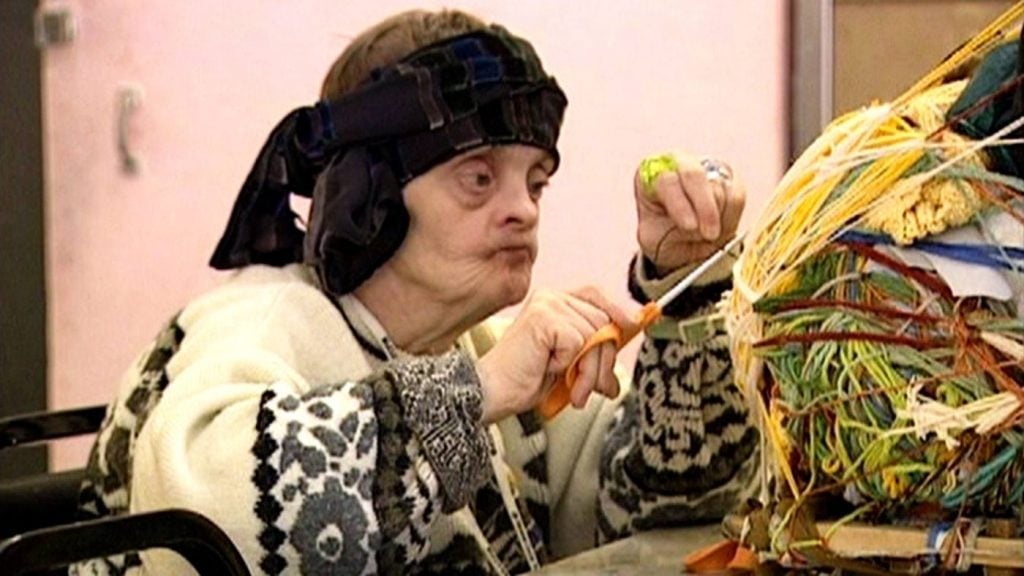
Judith Scott working at the Creative Growth Art Center in Oakland, California. Photo courtesy of the Creative Growth Art Center and Art21.
The sisters’ story had the potential to be a challenging one for young readers, dealing with themes of loss and loneliness.
“It seemed imperative to tell the story truthfully, and part of that is that Judith spent the first half of her life in an institution, and what that felt like for Joyce, being her twin,” Sweet said. “We were definitely concerned about doing it sensitively.”
“One day, I wake up and reach for my sister—but she is gone,” Joyce tells readers. “Just like that, my whole world disappears, and is replaced with the colors of gone.”
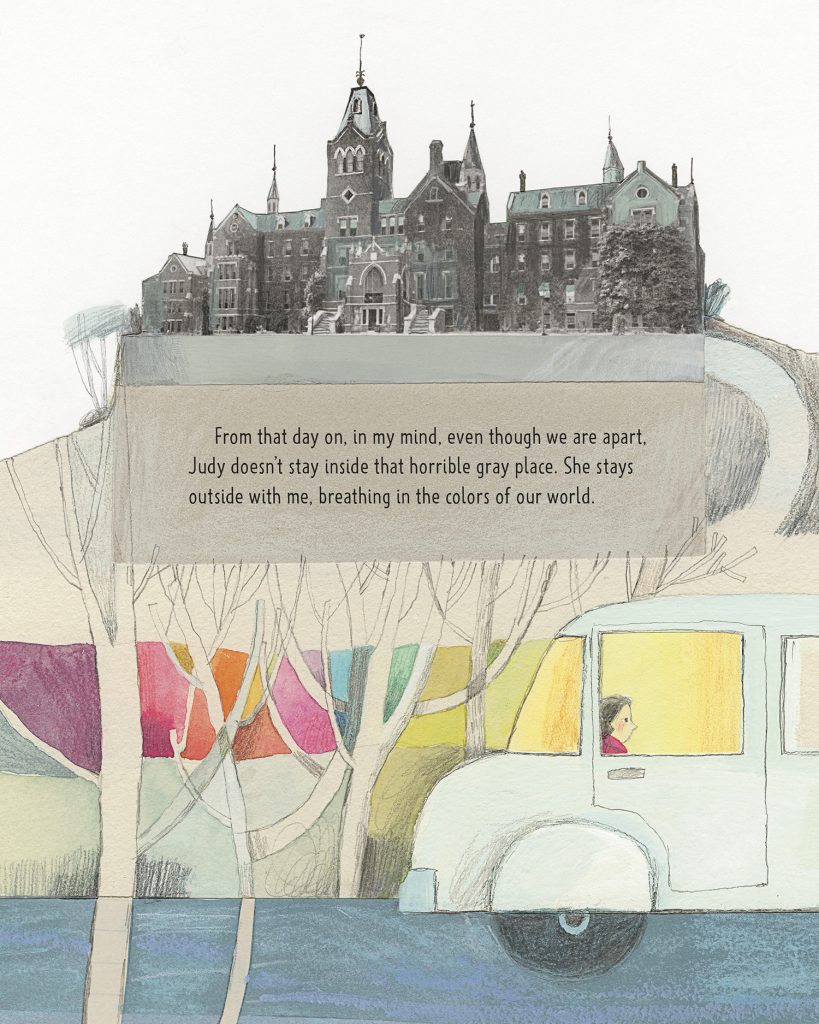
Joyce Scott, Brie Spangler, and Melissa Sweet, Unbound: The Life + Art of Judith Scott. Courtesy of Knopf Books for Young Readers, Penguin Random House.
Later, the two are depicted reuniting at the airport, with Judith wrapped in a hug by her sister, brother-in-law, and niece. It is a hopeful moment, and a turning point.
“When Joyce brought Judith to live with her in California, it was almost as if the stars aligned,” Sweet said.
The divide in Scott’s life, between her time in the institution and her eventual blossoming into an artist, plays out visually in Sweet’s illustrations, which start muted but grow more vibrant, featuring more of her hand-crafted three-dimensional objects as Scott taps into her unrealized creative potential.
Sweet hopes learning Scott’s life will inspire children, and will also help them understand disabilities.
“It is incredibly valuable to have conversations about what it’s like to be a person with disabilities in a world that’s not necessarily designed for them,” she said. “Even though the first half of her life was incredibly challenging and difficult to an extent that is hard even to comprehend, Judith’s resilience came through when given the opportunity for self expression. Everybody deserves that opportunity.”
See more illustrations from the book below.

Joyce Scott, Brie Spangler, and Melissa Sweet, Unbound: The Life + Art of Judith Scott. Courtesy of Knopf Books for Young Readers, Penguin Random House.
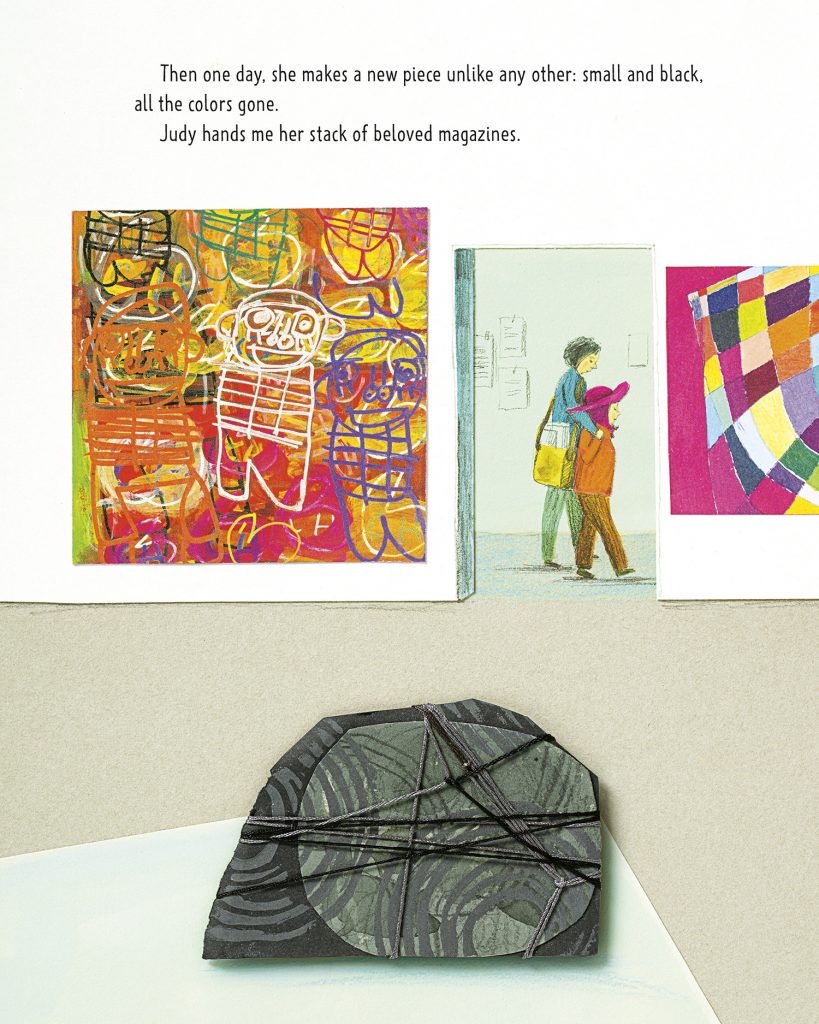
Joyce Scott, Brie Spangler, and Melissa Sweet, Unbound: The Life + Art of Judith Scott. Courtesy of Knopf Books for Young Readers, Penguin Random House.
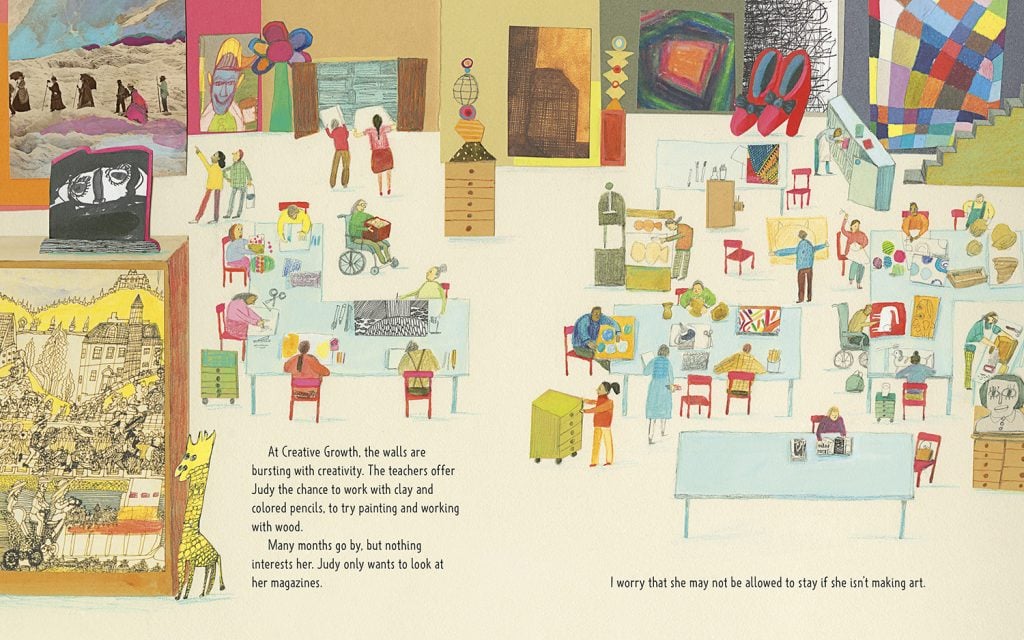
Joyce Scott, Brie Spangler, and Melissa Sweet, Unbound: The Life + Art of Judith Scott. Courtesy of Knopf Books for Young Readers, Penguin Random House.

Joyce Scott, Brie Spangler, and Melissa Sweet, Unbound: The Life + Art of Judith Scott. Courtesy of Knopf Books for Young Readers, Penguin Random House.

Joyce Scott, Brie Spangler, and Melissa Sweet, Unbound: The Life + Art of Judith Scott. Courtesy of Knopf Books for Young Readers, Penguin Random House.